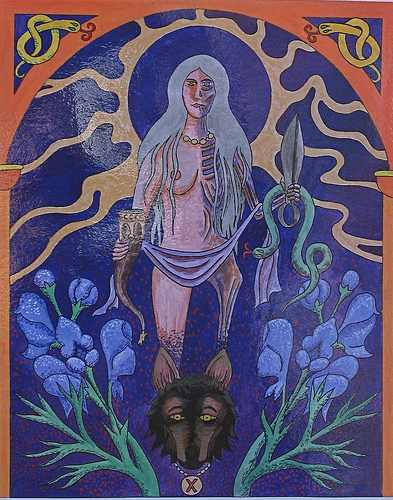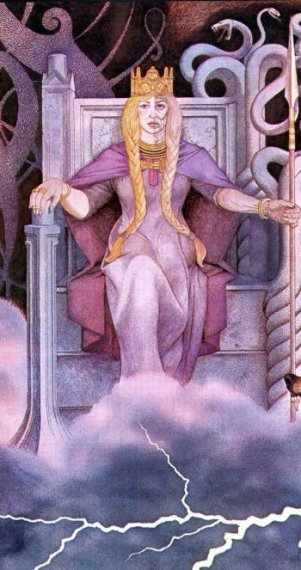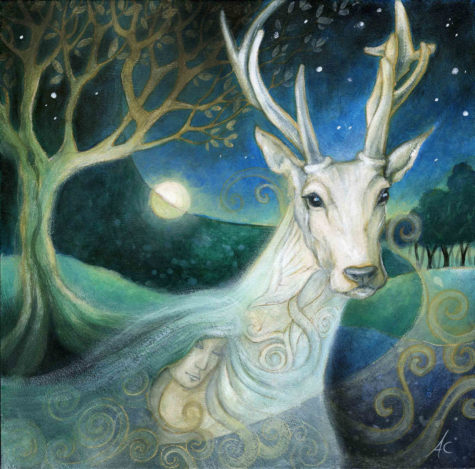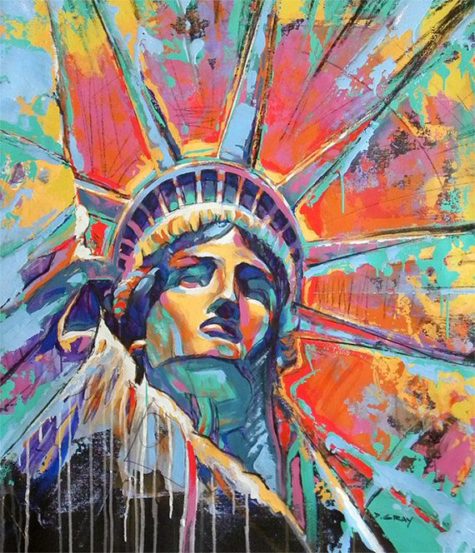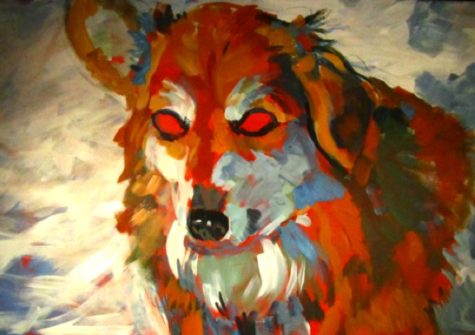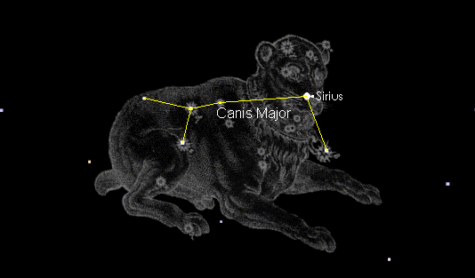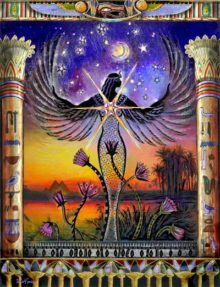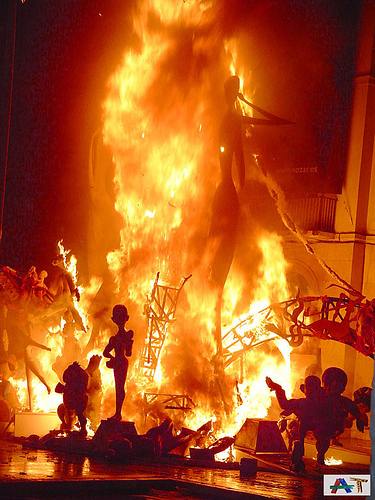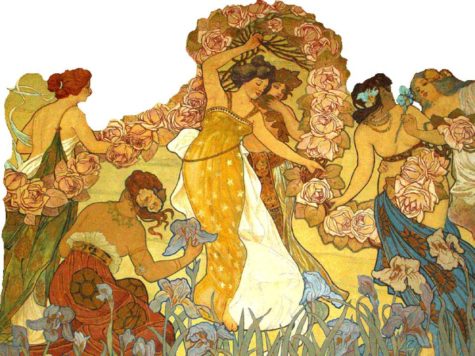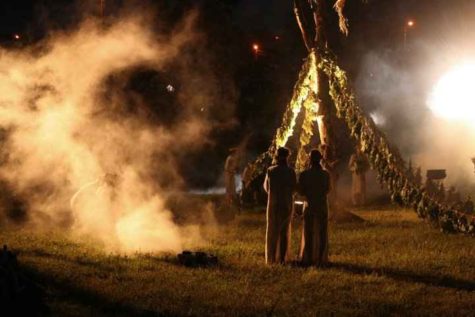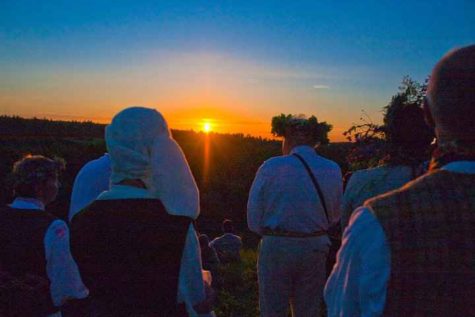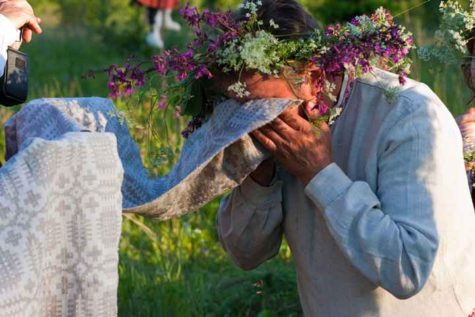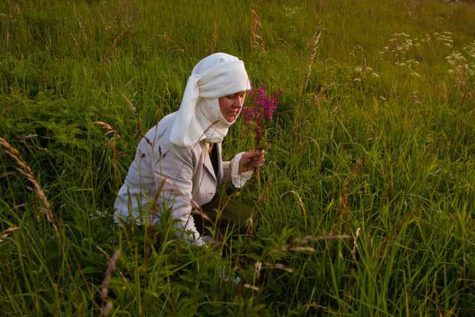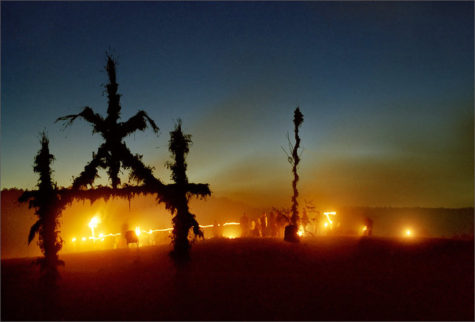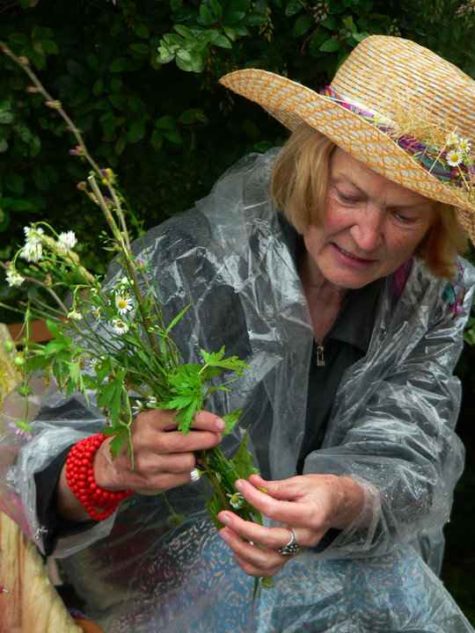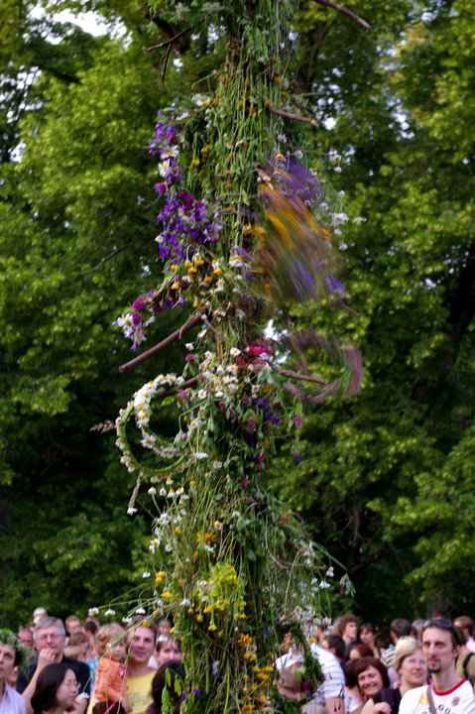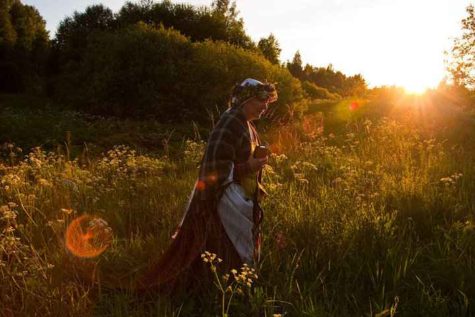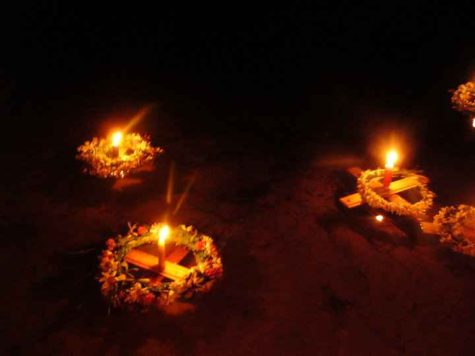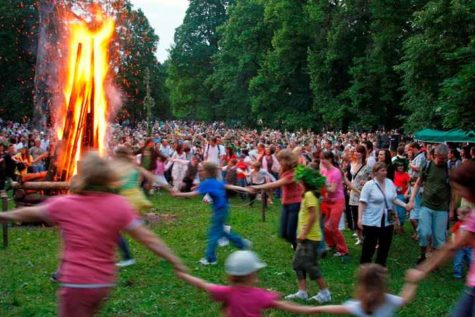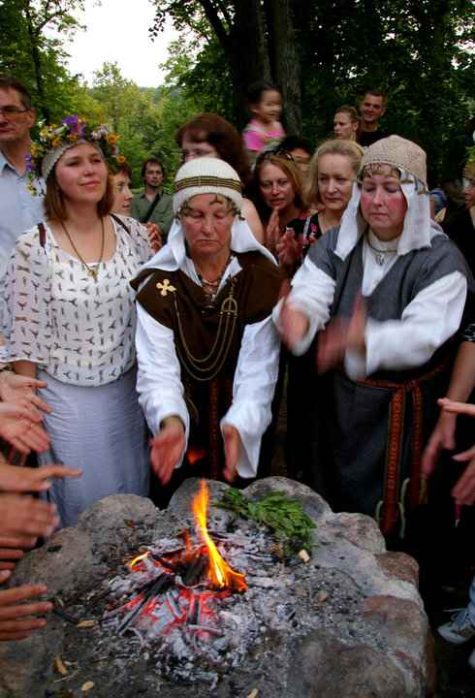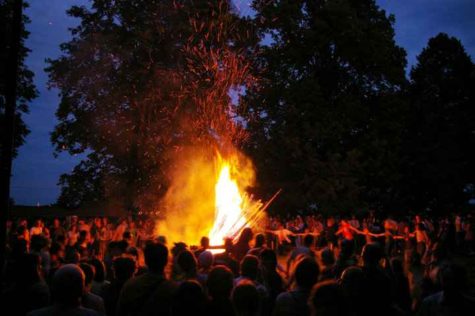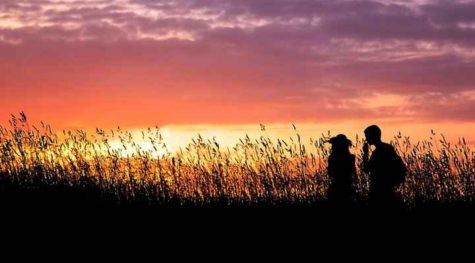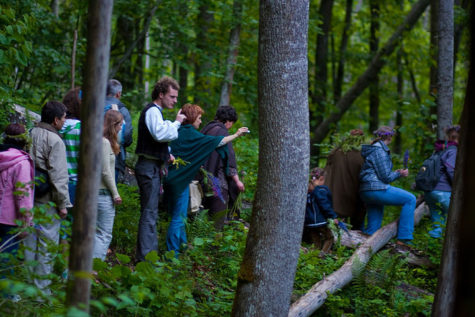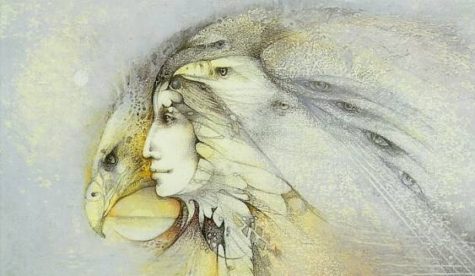The Anglo-Saxon and Norse Goddess of the Underworld is honored annually on the Day of Hel (July 10th) with prayers, the lighting of black candles, and offerings of rose petals.
About Hel:
Also known as Hella, Hela, this deity is simultaneously half-dead and half-alive. Half of her body (cut vertically) is that of a fair, beautiful woman; the other half is necrotized flesh. She is half living woman, half corpse.
Once upon a time, being sent to Hel may have been inevitable, but it wasn’t perceived as punishment: Hel, daughter of Angerboda and Loki, rules the Norse realm of the dead. She is the keeper of the souls of the departed. Those who die at sea or in battle have other destinations; everyone else goes to Hel, who welcomes them into her home, Helhaim, regardless of whether they were good, bad, sinful, or saintly while alive.
Here’s a ritual for Hela’s Day:
- Colors: Black and White
- Elements: Earth and Air
- Altar: Upon black cloth to the right place four black candles, a skull, bones, a pot of earth, a pile of withered leaves, and a gravestone. Upon white cloth to the left place four white candles, incense, an ivory chalice of mead, a crystal sphere, and a bunch of dried roses. Veil the windows.
- Offerings: Blood. Pain. Difficulty. Toil. An arduous task that will take all you have to give, and will benefit the generations yet to come.
- Daily Meal: Meat stew and bread.
Invocation to Hela
Hail to Hel
Queen of Helheim
Wisest of Wights
Keeper of Secrets
Keeper of the hopes for tomorrow
Guardian of Souls
Implacable one of the frozen realm
Half the face of beauty
Half the face of Death.
You who feed the dead
At your meager table
Where everyone gets their fair share,
You who care not
About wealth or status,
About fame or fortune,
Who cares for the peasant
Equally with the ruler,
Teach us that Death is the great leveller
And that we need have no pride
When we reach your halls.
Lady who takes away
Yet holds always promise,
Teach us to praise loss and death
And the passing of all things,
For from this flux
We know your blessings flow.
(Blow out the candles, bow to the altar, and pour out the libation of mead. The roses should be placed outside to rot in the garden.)
Found in: Pagan Book of Hours
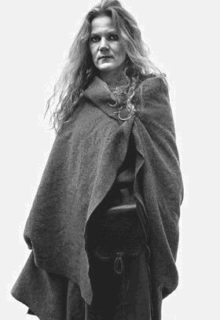 July 9th is the Day of Unn the Wise person. Also known as Aud the Deep-Minded, Unn was a great matriarch who established dynasties in the islands Orcadas, Feroe and Iceland.
July 9th is the Day of Unn the Wise person. Also known as Aud the Deep-Minded, Unn was a great matriarch who established dynasties in the islands Orcadas, Feroe and Iceland.
Example to follow:
Make our own families grow strong, maintain the memory and traditions of our alive ancestors. Remember the great women of your own clan on this Day of Remembrance for Unn the Deep Minded.
About Unn:
Unn was a powerful figure from the Laxdaela Saga who emigrated to Scotland to avoid the hostility of King Harald Finehair. She was the second daughter of Ketill Flatnose, a Norwegian hersir, and Yngvid Ketilsdóttir, daughter of Ketill Wether, a hersir from Ringarike. Unn married Olaf the White (Oleif), son of King Ingjald, who had named himself King of Dublin after going on voyages to Britain and then conquering the shire of Dublin. They had a son named Thorstein the Red
She established dynasties in the Orkney and Faroe Islands by carefully marrying off her grand daughters. Unn then set off for Iceland.
On her ship were twenty men, all of whom were free, but she was still the leader of them, proving that she was respected, but also that she was strong-willed enough to command a ship alone without the help of a man. In addition to the crew, there many other men on her ship, prisoners from Viking raids near and around Britain. They all came from good families, and were called bondsmen. Unn gave these men their freedom once they were in Iceland, making them freed-men, a class between slave and free, where they were not owned, but did not have all the rights of a free man. She also gave them all a great deal of land to farm on and make a living.
As a settler in Iceland she continued to exhibit all those traits which were her hallmark-strong will, a determination to control, dignity, and a noble character. In the last days of her life, she established a mighty line choosing one of her grandsons as her heir. She died during his wedding celebration, presumably accomplishing her goals and working out her destiny in this life. She received a typical Nordic ship burial, surrounded by her treasure and her reputation for great deeds.
Note:
In some pagan calendars this is shown of “Day of Un the Wise Person” which is a misprint.
Source: Asatru.org
July is normally the month when the new antlers of buck deer push out of their foreheads in coatings of velvety fur. It was also often called the Full Thunder Moon, for the reason that thunderstorms are most frequent during this time. It is known as the Hay Moon or the Meadow Moon because the meadows are at their greatest point of growth in this month, and it is a time for hay-cutting. Other names for this month’s Moon include: Blood Moon, Grain Moon, Green Corn Moon, Herb Moon, Hungry Ghost Moon, Wort Moon.
Native American fishing tribes called it the Sturgeon Moon because sturgeon, a large fish of the Great Lakes and other major bodies of water, were most readily caught during this month. A few tribes knew it as the Full Red Moon because, as the Moon rises, it appears reddish through any sultry haze.
The energies surrounding this full moon are ones of success, happiness, and fulfilment. We are blessed with the first harvest of the season – a reward for all our hard work. For this reason, July’s full moon is also known as the Blessing Moon. Energy moves into creation. Opportunities for self-reliance and confidence, unity and balance abound.
The Moon at this time brings us feelings of being connected. Connection to Spirit encourages us to first recognize blessings in our own lives, and then pay them forward – thus continuing the cycle of positive energy.
Correspondences:
- Colors: Green, silver, blue-gray
- Gemstones: Moonstone, white agate, opals or pearls
- Trees: Ash and oak
- Gods: Juno, Venus, Cerridwen, Athena, Nephthys, Lugh
- Herbs: Mugwort, hyssop, lemon balm
- Element: Water
This is a great time to do divination and dreamwork. Find a way to incorporate the watery energy of the Blessing Moon into your spell crafting and ritual. Enjoy the relaxing feeling of July’s full moon and use it in your personal meditation.
Celebrating the Full Buck Moon:
- Wear shades of green to honor the herb harvest
- Adorn your hair and altar with herbs and greenery
- Burn sage, lavender or rosemary incense
- Prepare herbal tea and lavender or lemon balm cookies
- Bless your herb garden
Collected from various sources
Independence Day (July 4th) is the “birth” of the United States is celebrated by Pagans and non-Pagans alike. Many patriotic Witches honor and give thanks to Lady Liberty, and perform magickal spells and rituals for the benefit of the country.
Historical Notes:
The Fourth of July commemorates the adoption of the Declaration of Independence by delegates from the 13 colonies in 1776. The Declaration of Independence is America’s revolutionary Charter of Freedom and the document upon which the nation’s founding principles were established.
The Second Continental Congress actually made its decree for freedom on July 2, 1776, signing the Lee Resolution. Two days later, on July 4, Congress formally adopted the Declaration of Independence and the alarm for freedom was sounded at Independence Hall with the Liberty Bell.
It was on August 4, 1776, after delegates of the Continental Congress had signed the document, that The Declaration of Independence was made official. John Adams’ famous letters to his wife, Abigail, on the 3rd of July, 1776, capture the spirit of the time. Writing from Philadelphia, he said,
Yesterday the greatest Question was decided, which ever was debated in America, and a greater perhaps, never was or will be decided among Men. A Resolution was passed without one dissenting Colony “that these united Colonies, are, and of right ought to be free and independent States, and as such, they have, and of Right ought to have full Power to make War, conclude Peace, establish Commerce, and to do all the other Acts and Things, which other States may rightfully do.”
I am apt to believe (this day) will be celebrated by succeeding generations, as the great Anniversary Festival. It ought to be commemorated, as the day of deliverance by solemn acts of devotion to God Almighty. It ought to be solemnized with pomp, shews, games, sports, guns, bells, bonfires and illuminations, from one end of the continent to the other, from this time forward forever.
Here is a brief excerpt from The Declaration of Independence. You can read the full text of the Declaration of Independence at www.archives.gov:
“We hold these truths to be self-evident, that all men are created equal, that they are endowed by their Creator with certain unalienable Rights, that among these are Life, Liberty and the pursuit of Happiness.
That to secure these rights, Governments are instituted among Men, deriving their just powers from the consent of the governed,
That whenever any Form of Government becomes destructive of these ends, it is the Right of the People to alter or to abolish it, and to institute new Government, laying its foundation on such principles and organizing its powers in such form, as to them shall seem most likely to effect their Safety and Happiness.”
Source: Almanac.com.
“These are strange and breathless days,
the dog days, when people are led to do things they are sure to be sorry for after.”
The Dog Days originally were the days when Sirius rose just before or at the same time as sunrise, which is no longer true, owing to procession of the equinoxes.
The Old Farmer’s Almanac lists the traditional period of the Dog Days as the 40 days beginning July 3rd and ending August 11th, coinciding with the ancient heliacal (at sunrise) rising of the Dog Star, Sirius. These are the days of the year with the least rainfall in the Northern Hemisphere.
These canicular days get their name from the Dog Star, Sirius, the brightest star in the constellation Canis Major. At this time of the year Sirius disappears into the Sun’s glow. Both heavenly bodies are in conjunction, rising and setting at around the same time. Ancient stargazers thought that the heat from Sirius, the brightest star in the heavens, combined with the heat of the Sun produced the hottest weather of the year! Even though Sirius is hotter than our Sun it is much too far away to warm our planet.
In Ancient Rome, the Dog Days ran from July 24th through August 24th, or, alternatively, from July 23 through August 23rd. The period was reckoned as extending from 20 days before to 20 days after the conjunction of Sirius (the dog star) and the sun.
The Romans sacrificed a brown dog at the beginning of the Dog Days to appease the rage of Sirius, believing that the star was the cause of the hot, sultry weather. In many European cultures (German, French, Italian) this period is still said to be the time of the Dog Days.
Since its rising also coincided with a time of extreme heat, the connection with hot, sultry weather was made for all time:
“Dog Days bright and clear indicate a happy year.
But when accompanied by rain, for better times our hopes are vain.”
The ancient Egyptians saw Sirius as a giver of life for it always reappeared at the time of the annual flooding of the Nile. When the star sank in the west and disappeared from the night sky, it remained hidden for 70 days before emerging in the east in the morning. This was viewed as a time of death and rebirth. The Egyptians copied this period in their funeral ceremonies. When a king died, his body was mummified, then interred in a pyramid or other tomb. By custom, burial took place 70 days after death, when the king was “reborn” in the stars.
Sirius was astronomically the foundation of their entire religious system. It was the embodiment of Isis, sister and consort of the god Osiris, who appeared in the sky as Orion. This is the period of time Sirius disappears from the sky — sequenced in the myth when Isis is hiding until the birth of her son, Horus — eventually the star reappears after Horus is born — resurrection.
On the first day of Sirius’ reappearance the ancient Egyptians expected an abundant harvest, if the star appeared bright and clear. If Sirius appeared dull and red, a poor harvest would result.
The Dog Star, Sirius is also known as our Spiritual Sun, esoterically the cosmic heart of our physical Sun. During the Dog Days when Sirius disappears into the Sun’s glowing light, it could be said that our physical Sun is embracing our Spiritual Sun! After such a celestial union a rebirth or resurrection can be expected.
Dog Days were popularly believed to be an evil time according to Brady’s Clavis Calendaria, 1813:
“the Sea boiled, the Wine turned sour, Dogs grew mad, and all other creatures became languid; causing to man, among other diseases, burning fevers, hysterics, and phrensies.”
The 1552 edition of the The Book of Common Prayer, way the “Dog Daies” begin July 6th and end August 17th. This corresponds very closely to the lectionary of the 1611 edition of the King James Bible (also called the Authorized version of the Bible) which indicates the Dog Days beginning on July 6th and ending on September 5th.
Note:
A recent reprint of the 1662 edition of the Book of Common Prayer contains no reference to the Dog Days. In the Southern Hemisphere, they typically occur in January and February, in the midst of the austral summer.
Honoring the Dog Days
- Themes: Fertility; Destiny; Time
- Symbols: Stars; Dogs
- Presiding Goddess: Sopdet
About Sopdet:
The reigning Egyptian Queen of the Constellations, Sopdet lies in Sirius, guiding the heavens and thereby human destiny. Sopdet is the foundation around which the Egyptian calendar system revolved, her star’s appearance heralding the beginning of the fertile season. Some scholars believe that the Star card of the tarot is fashioned after this goddess and her attributes.
Note: The dog days and the dog star Sirius are also associated with the Egyptian Goddess Hathor..
To Do Today:
The long, hot days of summer are known as “dog days” because they coincide with the rising of the dog star, Sirius. In ancient Egypt this was a welcome time as the Nile rose, bringing enriching water to the land. So, go outside at dawn, and welcome the Sun. Make an offering of water, and whisper a wish to Sopdet suited to her attributes and your needs. For example, if you need to be more timely or meet a deadline, she’s the perfect goddess to keep things on track.
If you’re curious about your destiny, watch the eastern region of the sky in the evening and see if any shooting stars appear. If so, this is a message from Sopdet. A star moving on your right side is a positive omen/ better days ahead. Those on the left indicate a need for caution, and those straight ahead mean things will continue on an even keel for now.
Nonetheless, seeing any shooting star means Sopdet has received your wish.
Source: Wikipedia and Almanac.com and 365 Goddess
Today, July 3rd, is the Festival of Cerridwin.
This festival honors the Welsh mother goddess, Cerridwin who embodies all lunar attributes and the energy of the harvest, specifically grains. In Celtic mythology, Cerridwin owned a cauldron of inexhaustible elixir that endowed creativity and knowledge.
The Festival of Cerridwin, coming as it does at the halfway point of the year, provides motivation to keep on keeping on. Her symbol is a pig, an animal that often represents good fortune and riches, including spiritual enrichment.
Suggestions for today:
Get creative! Use a special cup, bowl, or vase set in a special spot to represent Cerridwin’s creativity being welcome in your home. Fill the receptacle with any grain-based product (like breakfast cereal) as an offering. Whisper your desire to the grain each time you see it or walk by. At the end of the day, pour the entire bowl outside for the animals. They will bear your wish back to the goddess.
Other ideas include the following:
Today is definitely a time to consider having bacon for breakfast, a ham sandwich for lunch, or pork roast for dinner to internalize Cerridwin’s positive aspects. Vegetarians? Fill up your piggy bank with the odd change you find around your house and apply the funds to something productive to inspire Cerridwin’s blessing.
Source: 365 Goddess
Bonfires of Saint John is a popular festival celebrated around June 24, (Saint John’s day) in several towns in Spain. For this festival, people gather together and create large bonfires from any kind of wood, such as old furniture, and share hot chocolate while teens and children jump over the fires.
A pie of tuna (coca anb tonyina) and early figs (bacores) is traditionally eaten while setting up the events.
The festival is celebrated throughout many cities and towns; however, the largest and most elaborate version is in Alicante. On the night of St John, gigantic (20 to 30 foot high) explosive caricatures (ninots) are paraded through the streets and exploded in a spectacular finale with fireworks and pyrotechnics, making this festival into the most important (and loudest!) cultural event in Alicantinian society.
Collected from various sources
In ancient Rome, this day (June 24) was known as the Festival of Fata, the Goddess of Fate and Chance. She was more commonly called Fortuna, and this day was also known as the Festival of Fortuna. The Temple of Fortuna stood on the banks of the Tiber and on this day many Romans would make a pilgrimage on foot or by boats decorated with garlands of flowers. Fortuna was especially popular with poorer Romans and the servant class, who sought the blessings that more successful Romans already had.
About Fortuna:
Initially Fortuna, the Roman goddess of abundance, was honoured as a fertility goddess, but came to symbolise abundance as the fickleness of life and luck followed the cyclic ups and downs of life. She was invoked for good luck and prosperity, or lamented to during times of hardship.
She is usually depicted holding a rudder in one hand, steering our destiny as our karmic path progresses, and/or a cornucopia (or horn of plenty) signifying the wealth that she could bring. Often she has a wheel beside her, reminding us that she is the benefactor of life, death, and the wheel of fortune.
From ancient times people marked the time of the return of the sun, the shortest and longest night. In olden times it was called the Feast of the Dews- Rasos. When Christianity was established in Lithuania, the name was changed to Feast of St. John, according to agrarian folk calendar, the start of haying.
The rituals of the longest day were closely related to agrarian ideas and notions. The main aim was to protect the harvest from natural calamities, evil souls, witches and mid summer visitors like drought, hail, downpours of rain and thunder.
In the 15th century, visitors to Lithuania wrote that in Vilnius, the celebrations took place in the eastern section of the city, the place of the present day “Rasos” cemetery. Fires were lit on hills and in dales. People danced, sang, ate and drank. On the Feast of St John a special role was granted to the sun. The sun is constantly mentioned in songs sung on the longest day of the year.
On this ritual day, farmers paid special attention to water’s special powers in reviving soil and making it productive. Witching on this day were carried out near and with water, people washed themselves and their animals. Special attention was paid to the dew because it revives plants at night. At sunrise farmers made their way around the fields, pulling a branch which brushed the dew to fall into the soil and cause a good harvest.
Maidens tried to get up before sunrise, collect the dew and wash their faces with it to make them bright and beautiful. They would also get up at night, go outside to wet their faces in the dew and returned to bed without wiping their faces dry. If that night they dreamt of a young man bringing them a towel, they hoped that he would be the one they would marry.
Flourishing plants were worshiped because it was believed that plants collected on the eve of the Feast of St. John posses magic powers to heal, bring luck and foretell the future. This is an ancient ritual practiced mainly by women. Roses, common daisies, especially the herb St. John’s worth and numerous grasses were some of the main plants collected at this time.
A festival pole, decorated with flowers and greenery was called “Kupolė”. Folklore shows that “Kupolė” was the Goddess of plants, living in aromatic plants, blossoms or in buds in summer and in snowdrifts in winter.
In Lithuania Minor, even in winter before the Feast of St. John, women made haste to collect medicinal herbs, with the belief that after June 24th all herbs lose their healing powers.
Girls returned to the village after picking flowers and singing, wreathed the festival post, “Kupolė”, and added colorful fluttering ribbons to it. This festival post was set at the far end of the village, near the grain fields. It had to be defended during two days and nights from young men who tried to steal it.
After saving the post, the girls removed the decorative herbs and grasses and divided them amongst themselves because these herbs had special protective powers against evil spirits and illnesses.
In some regions bunches containing nine plants were gathered by women on the eve of the Feast of St. John. Some of the plants were fed to animals before midnight, so they would be protected from evil eyes. Bunches of St. John’s worth were placed behind pictures of saints. If this bunch did not wilt fast, it was believed that it will be a lucky year.
It was believed that wreaths concentrate perpetual life’s forces and are symbols of immortality and life. There were many rites and witching’s associated with wreaths during this longest summer’s night.
Walk around three fields and gather bunches of nine flowers, twine a wreath and place it under your pillow. You will marry the man, who in your dream comes to take away the wreath. At midnight, twelve wreaths were dropped into a river and observed if they were pairing off. If no pairing off occurred, there was to be no marriage that year.
Near the river Nemunas, wreaths were dropped in the water, only when the river was calm and observed to which direction they drifted. Matchmakers would come from that direction. Releasing the wreath with the current, it will be caught by a young man, the maiden will be his. Should the wreath float away without being caught, the maiden will keep that wreath all year in her dowry chest, as a symbol of luck and health.
In the seacoast region, all during the night, young men and women twined wreaths from ferns, placed candles and set them in streams. Should both their wreaths swim together, they believed that they would marry that year.
In some regions wreaths twined during the night of the Feast of St. John were placed at crossroads with the belief that ones future will be seen in a dream.
The rites of this day continued till sunrise around bonfires. The site selected for ritual bonfires was always in the most beautiful area, on hills, on river shores and near lakes. In some regions bonfires were lit on future grain fields and under linden trees.
Those who are not fond of socializing on the eve, hurry and gather along lake shores, light bonfires, place burning poles, covered with tar into trees, so that there would be light all night long until sunrise. Special decorated wheels were lit and were rolled down hillsides, this symbolized the sun’s moving away from the earth and at the same time a request for her return.
In ancient times, the ritual fires were lit by senior priests, “vaidilos”. That fire was started with sparks coming from rubbing dried roots of medicinal herbs or from flying sparks when striking flint stones. Such fires would protect from epidemics, illnesses, poor harvests, hail and lightning.
Eggs were thrown into the fires and animals sacrificed. Later straw dolls were sacrificed in place of animals.
The ritual fires were built up to throw their light over a large area of fields, to assure a big autumn harvest. On the eve of this feast day, home fires were put out and new fires were lit using glowing coals from the ritual fires of that day.
It was believed that these ritual fires had special powers, which would protect from misfortunes, bring health and harmony to the family. It was important for newlyweds to light the fire in their hearth with the coals of the miraculous ritual fire. Such a family would be blessed, live well and in total harmony.
Jumping over fires or around it had magic meaning. Ritual bonfires cleansed both physically and psychologically. Sick adults and children were brought to the ritual fires and were pulled through the fire, with the belief that they would be healed. Jumping over the fire was carried out with the belief of making better health, increasing body strength for hard summer labors and assuring better growth of grain and flax.
Ritual fires’ ashes, smoldering coals had special powers to increase the harvest and protect it from natural calamities. The coals were dug under in fields; ashes were sprinkled on crops to assure good crop yields. To keep weeds from growing in grain fields, ritual fires’ wood splinter remains were tied to the plough share when ploughing the fields.
The feast of St. John is connected with summer weddings and their rituals which were bound to affect family living and population increases. Should a pair become friends this night, there will definitely be a wedding.
The night of June 24th is the shortest night of the year, filled with bird sounds and luxuriant vegetation. Darkness substitutes light unnoticeably, night is full of miracles due to fire reflections and shadows. It was believed that activity during this night of supernatural creatures or female witches was ill disposed towards men, animals and plants. To keep animals from their malevolent actions, animals were put in barns before sunset and were fed bread with salt for protection. Mountain ash branches and wheat sprays were hung on door posts for protection against evil spirits
In some regions clogs were placed in front of a mirror. Witches would step into the clogs and run away upset by their frightful image in the mirror.
“Šatrija” was the most famous witches’ hill, where during the night of the Feast of St. John, witches party and rage all night and invent all kinds of enchanting. This is why one could not do without “witches’ burnings”. Young people tied a barrel filled with tar and sawdust to a high pole, sprinkled it with salt so that the witches would crackle. The barrel was set on fire while the young people sang and danced merrily. Next morning the cow herd was driven through the remaining ashes, with the belief that witching’s will no longer be harmful.
During the night of the Feast of St. John, the miraculous fern bursts into bloom. It is difficult to catch sight of this bloom; however this difficulty can be overcome by going to the forest the day before, cutting down a mountain ash, pruning the branches and cutting off the top. Then pulling the tree backwards, walk about one hundred steps without looking back, toward the side to which the cut tree fell.
Look back after the hundred steps and then you will see the devil sitting stuck in the ash tree. The devil will ask for your help to get off the tree and for your help will tell you where to find the blooming fern. When you locate the blooming fern, ghosts will attack with butting horns whirlwinds will howl and cats will cry. Then take a cane made of mountain ash, draw a circle around you with it, spread a linen cloth and stop being afraid. The fern blossom will fall on the cloth. Some say that the fern bloom is like birch dust, others describe it as round and white like carp’s scale.
Prepared by: http://ausis.gf.vu.lt/eka/
Photos by: Gintaras Jaronis, Vytautas Darasevičius, Leonardas Šidlauskas and A. Kiričenko.
- Themes: Freedom; Perspective; Overcoming; Health; Power; Destiny; Air Element; Movement
- Symbols: Feathers (not Eagle – gathering these is illegal)
- Presiding Goddess: Mother of All Eagles
About the Mother of All Eagles:
On the warm summer winds, Eagle Mother glides into our reality, carries us above our circumstances, and stretches our vision. Among Native Americans, the Eagle Mother represents healing, her feathers often being used by shamans for this purpose. Beyond this, she symbolizes comprehension, finally coming to a place of joyfully accepting our personal power over destiny.
To Do Today:
On this day (June 20), in 1982, President Reagan declared Bald Eagle Day to honor the American emblem of freedom. In Native American tradition, this emblem and the Eagle Mother reconnect us with sacred powers, teaching us how to balance our temporal and spiritual life on the same platter.
Find a new, large feather for an Eagle Mother talisman. Wrap the pointed end with cloth crisscrossed by leather thongs or a natural fabric ribbon. Each time you cross the leather strings, say:
______ bound within;
when released by wind, let the magick begin.
Fill in the blank with the Eagle Mother attributes you desire, then have the feather present or use it in rituals or spells to disperse incense, thereby releasing its magic on the winds.
From 365 Goddess
